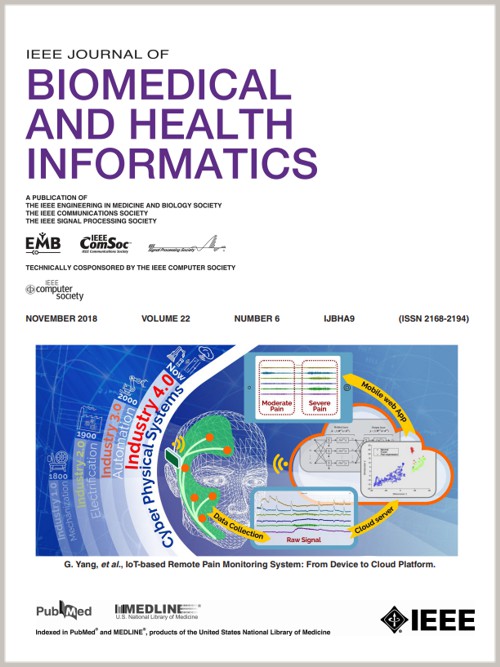用于三导联脑电图传感器辅助抑郁症诊断的板载可执行多特征转移增强融合模型。
IF 6.8
2区 医学
Q1 COMPUTER SCIENCE, INFORMATION SYSTEMS
IEEE Journal of Biomedical and Health Informatics
Pub Date : 2024-10-28
DOI:10.1109/JBHI.2024.3487012
引用次数: 0
摘要
随着情感计算和医疗电子技术的发展,出现了基于人工智能(AI)的抑郁症早期检测方法。然而,以往的研究往往忽视了人工智能辅助诊断系统在实际抑郁症识别场景中可穿戴和可访问的必要性。在这项工作中,我们基于从 73 名抑郁症患者和 108 名健康对照者收集到的脑电图数据,为定制设计的可穿戴三导联脑电图(EEG)传感器提出了一个板载可执行多特征转移增强融合模型。实验结果表明,所提出的模型具有计算复杂度低(65.0 K 个参数)、浮点运算(FLOPs)性能好(26.6 M)、实时处理(1.5 s/执行)和功耗低(320.8 mW)等特点。此外,在脑电图传感器上部署时,它只需要 202.0 MB 的随机存取存储器 (RAM) 和 279.6 KB 的只读存储器 (ROM)。尽管该模型的计算和空间复杂度较低,但在独立测试条件下,其分类准确率高达 95.2%,特异性高达 96.9%,灵敏度高达 94.0%。这些结果凸显了在可穿戴三导联脑电图传感器上部署该模型以辅助诊断抑郁症的潜力。本文章由计算机程序翻译,如有差异,请以英文原文为准。
An On-Board Executable Multi-Feature Transfer-Enhanced Fusion Model for Three-Lead EEG Sensor-Assisted Depression Diagnosis
The development of affective computing and medical electronic technologies has led to the emergence of Artificial Intelligence (AI)-based methods for the early detection of depression. However, previous studies have often overlooked the necessity for the AI-assisted diagnosis system to be wearable and accessible in practical scenarios for depression recognition. In this work, we present an on-board executable multi-feature transfer-enhanced fusion model for our custom-designed wearable three-lead Electroencephalogram (EEG) sensor, based on EEG data collected from 73 depressed patients and 108 healthy controls. Experimental results show that the proposed model exhibits low-computational complexity (65.0 K parameters), promising Floating-Point Operations (FLOPs) performance (25.6 M), real-time processing (1.5 s/execution), and low power consumption (320.8 mW). Furthermore, it requires only 202.0 KB of Random Access Memory (RAM) and 279.6 KB of Read-Only Memory (ROM) when deployed on the EEG sensor. Despite its low computational and spatial complexity, the model achieves a notable classification accuracy of 95.2%, specificity of 94.0%, and sensitivity of 96.9% under independent test conditions. These results underscore the potential of deploying the model on the wearable three-lead EEG sensor for assisting in the diagnosis of depression.
求助全文
通过发布文献求助,成功后即可免费获取论文全文。
去求助
来源期刊

IEEE Journal of Biomedical and Health Informatics
COMPUTER SCIENCE, INFORMATION SYSTEMS-COMPUTER SCIENCE, INTERDISCIPLINARY APPLICATIONS
CiteScore
13.60
自引率
6.50%
发文量
1151
期刊介绍:
IEEE Journal of Biomedical and Health Informatics publishes original papers presenting recent advances where information and communication technologies intersect with health, healthcare, life sciences, and biomedicine. Topics include acquisition, transmission, storage, retrieval, management, and analysis of biomedical and health information. The journal covers applications of information technologies in healthcare, patient monitoring, preventive care, early disease diagnosis, therapy discovery, and personalized treatment protocols. It explores electronic medical and health records, clinical information systems, decision support systems, medical and biological imaging informatics, wearable systems, body area/sensor networks, and more. Integration-related topics like interoperability, evidence-based medicine, and secure patient data are also addressed.
 求助内容:
求助内容: 应助结果提醒方式:
应助结果提醒方式:


